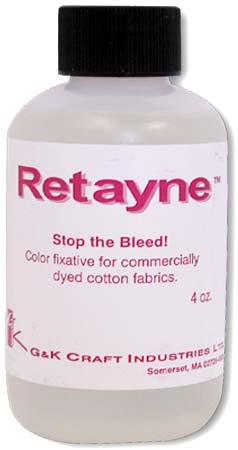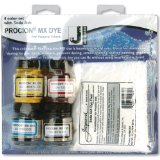Do I need to remove a dark brown prior to dyeing or can I dye right over the brown & achieve an eggplant type purple?
Name: Terre
—ADVERTISEMENTS—

G&K Craft Retayne Color Fixative, 4-Ounce
Retayne is the most economical and effective
of the color fixative aftertreatments. It makes Rit dye stay bright much longer, instead of fading quickly in the wash.


Rit Dye Liquid Fabric Dye, 8-Ounce, Purple
Rit All Purpose Dye is a hot water dye, best applied in boiling water. It is not safe to use Rit Dye in cooking pots that will be reused for food preparation. Rit Dye fades quickly in the wash, compared to Procion dye, but a dye fixative such as Retayne can help it to last much longer.


Jacquard Products Procion Four Color MX Dye Set with Soda Ash
Procion MX fiber reactive dyes can be used to mix any color you wish. Must be used with soda ash or washing soda as a fixative; machine dyeing also requires salt.

Country or region: USA
Message: I hope I'm not asking questions already asked-I did check the FAQ. I've read numerous articles on dyeing & now I'm totally confused; having problems from a head injury doesn't help. I have a dark brown, 100% cotton dress with some silk(?) ribbon bands sewn on around the hem line & several other places, as well as some crocheting at the top. I want to dye it dark purple. I have liquid Rit dye, Rit color remover, soda ash fixative & Retayne. Do I need to remove the brown prior to dying or can I dye right over the brown & achieve an eggplant type purple? I'm leaning toward a stove top method. How do I go about this? I've read all kinds of instructions from a multitude of sites (including Rit) & now I'm overwhelmed & just plain confused. Any help & direction you can give me would be so very appreciated. Thank you for your time & trouble.
First, do not bother with the soda ash. Soda ash works as a dye fixative for fiber reactive dyes, such as Procion MX dyes, but it does nothing to fix Rit all purpose dye. Save the soda ash for another project.
You will need to remove some of the dark brown color from your dress before you can dye it. If you had a light brown dress, then you could use purple dye to get a brownish purple, but purple dye will not do much to change the color of a dark brown dress. Dark brown is such a dark and muddy color that the only other color you can dye it is black. Other colors are too light to change a dark brown. The original dark brown color will always show through.
Rit Color Remover is a good choice for lightening the color of your dark brown dress. (see "What chemicals can be used to remove dye?".) It might not work, depending on the dye, but that's always the risk, with color removing. There are two different choices for how to use the Rit Color Remover. The most effective way is on the stovetop, but the easiest way is in the washing machine. The difference in the amount of effort trouble is so great that I always try the washing machine first. You will need at least two or three boxes of Rit Color Remover for the washing machine method. Use the hottest water possible, because Rit Color Remover needs very hot water. It will not work in cool water. If the washing machine method does not remove enough of the color, you can try again with Rit Color Remover in a huge cooking pot for the stovetop method. Chlorine bleach in the washing machine is also a possibility (wash the color remover out of the dress before using bleach), but it will damage any non-cotton fibers in the dress, especially including silk or nylon. Rit Color Remover is kinder to delicate fibers than bleach is.
The "silk" ribbons on the dress are probably not made of silk, by the way; decorations are more usually made of synthetic materials. Rit Color Remover is a good choice for the trim, but it's impossible to predict whether their color will change as much, or more than, the color of the dress. They may look just fine in the original color, though, after you dye the dress a dark purple.
Don't try dyeing until after you have lightened the dress considerably. The dress does not need to be white for you to dye it, but it does need to be a lighter color than dark brown. After you're done with the Rit Color Remover, wash the dress, before you try to dye it.
Rit All Purpose Dye is a mixture of a kind of dye called direct dye, for cotton and rayon, and another kind of dye called acid dye, for wool, silk, and nylon. It must be applied in very hot water. You can apply it in a washing machine; applying it in a huge cooking pot is more effective, but you should not use one of your good cooking pots to dye in. You should not plan to reuse a dyeing pot for cooking, later on. Rit Dye is not safe for use in food preparation containers. If you do not want to use hot water to dye, you can buy a different kind of dye; Procion MX fiber reactive dye is a cool water dye which, unlike Rit, works in room-temperature water. You can use Procion dye without heating it, so a plastic bucket makes a perfectly good container for dyeing a dress with Procion dye, but a plastic bucket is no good at all for dyeing with Rit dye.
For instructions for using Rit dye in the washing machine, you can see the Rit dye website. One bottle of liquid Rit dye is equivalent to two boxes of powdered Rit dye. You will also need to add salt. Personally, I prefer to use Procion MX dye in the washing machine; see "How can I dye clothing or fabric in the washing machine?". However, Rit All Purpose Dye has the advantage of also working on nylon, though not polyester, and it can be satisfactory if treated afterwards with a cationic dye fixative and always laundered carefully.
After you have completed dyeing, after you have rinsed out the excess dye, you can use the Rit Fixative. It is a very similar product to Retayne Dye Fixative, both being cationic dye fixatives, though it is much more expensive because each bottle is highly diluted with water, whereas the Retayne brand is far more concentrated. Weigh your dress when it is still dry so that you will know how much of the Rit Dye Fixative to use. One 4-ounce bottle of Rit Dye Fixative contains enough dye fixative to treat two pounds of fabric. (The same size bottle of Retayne is sufficient to treat twelve times as much fabric.) It is very easy to apply; just add the contents of the bottle to a large bucket of very hot water or to a washing machine full of very hot water, add the dress, and agitate or stir it for fifteen minutes. After applying the fixative, wash the dress in cool water before wearing the dress.
Even after using Rit Fixative, you should be careful to wash the dyed dress only in cool water, separately from other colors. Rit Fixative helps considerably in prolonging the life of a Rit dye job, but, even so, Rit Fixative will eventually wash out in hot water, and Rit All Purpose Dye runs badly in the laundry. Washing in cool water will prolong the life of both the Rit Fixative and Rit All Purpose Dye, and washing separately will minimize damage to other clothing when the Rit All Purpose Dye does run.
Each of these steps can be done on a different day, if your health is not up to doing it all in one day. Please let me know how it works out for you.
(Please help support this web site. Thank you.)
(Please help support this web site. Thank you.)
Posted: Tuesday - July 09, 2013 at 09:29 AM
Follow this blog on twitter here.
Quick Links
- All About Dyes & Dyeing Top -
- Top of this blog -
- FAQ -
- The Dye Forum -
- How to Tie Dye - How to Batik -
- Books - Toys - Plants -
- Top of this blog -
- FAQ -
- The Dye Forum -
- How to Tie Dye - How to Batik -
- Books - Toys - Plants -
More in this category:
- -
Statistics
Total entries in this blog:
Total entries in this category:
Published On: Jul 09, 2013 12:37 PM
Total entries in this category:
Published On: Jul 09, 2013 12:37 PM